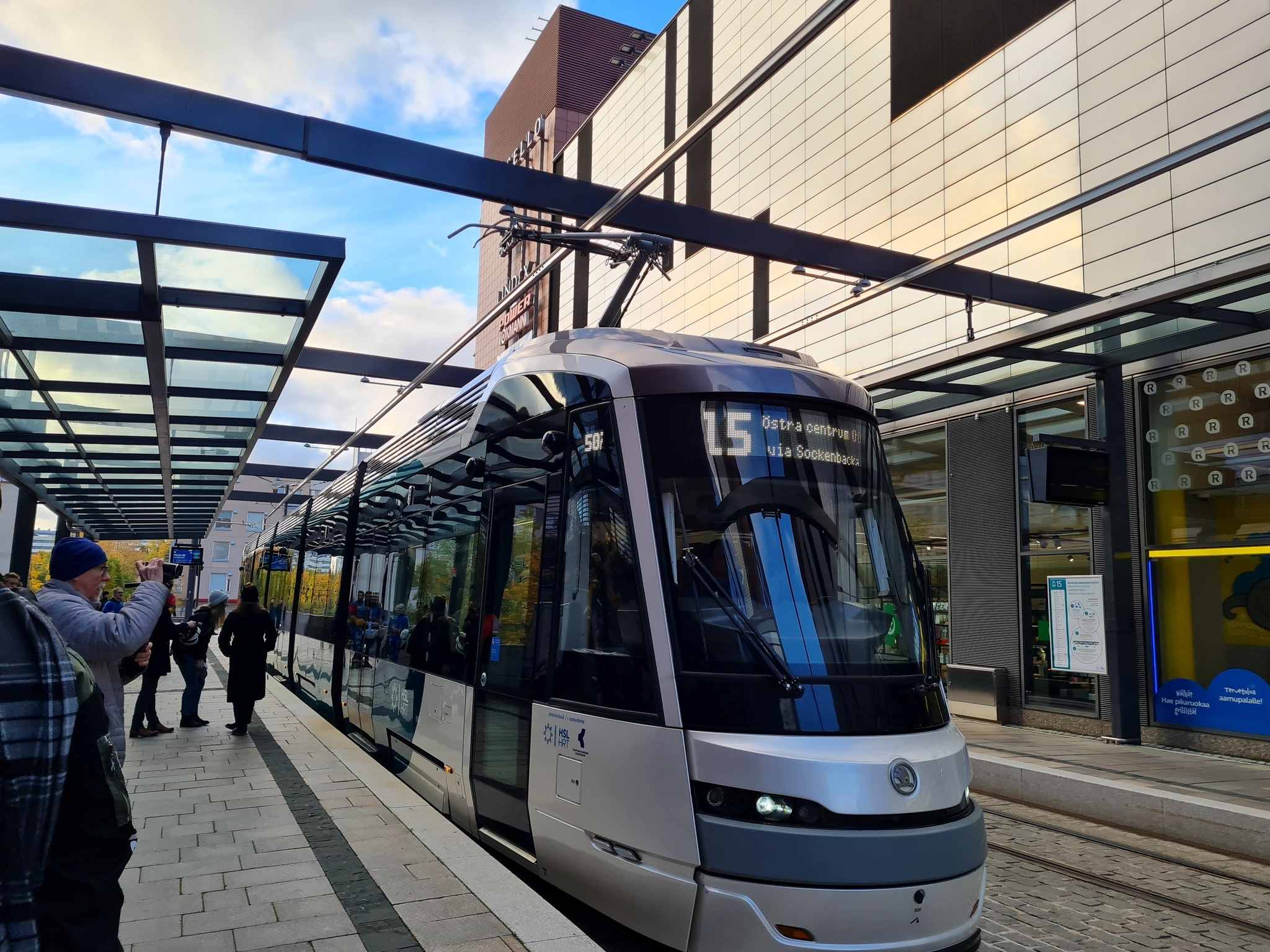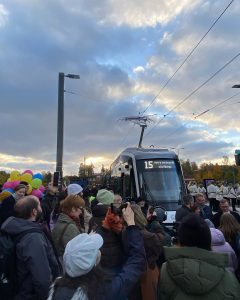Helsinki and Espoo are large Finnish cities that share a high level of activity, with mobility being a priority both in each city and in the shared connections. The authorities of both cities are focusing on developing public transport and encouraging citizens to adopt this mobility to help decarbonise transport and achieve zero emissions. Although the two cities have public transport rail links between them, this has not prevented the authorities from building a new link, which was put into operation before the originally planned completion.
 Espoo is the second largest city in Finland and is located about 20 km south of the capital Helsinki, with a population of 289,731 (in 2020). The city has sustainability-based policies that address mobility, the building sector and the energy sector and focuses on solutions, projects and actions to ensure a sustainable future, with the main goal of achieving carbon neutrality in 2030, which means an 80% reduction in greenhouse gas emissions, with the remaining 20% being the share of carbon that can be absorbed mainly by carbon sinks, referring to the increase in carbon stocks such as growing forests.
Espoo is the second largest city in Finland and is located about 20 km south of the capital Helsinki, with a population of 289,731 (in 2020). The city has sustainability-based policies that address mobility, the building sector and the energy sector and focuses on solutions, projects and actions to ensure a sustainable future, with the main goal of achieving carbon neutrality in 2030, which means an 80% reduction in greenhouse gas emissions, with the remaining 20% being the share of carbon that can be absorbed mainly by carbon sinks, referring to the increase in carbon stocks such as growing forests.
Espoo’s development strategy states that Espoo intends to achieve the Sustainable Development Goals (SDGs) by 2025, and to this end, the local authority is working with companies and other partners to create and introduce solutions that provide citizens with access to easy, fast and quality services based on the concept of sustainability.
The period 2021-2025 is the third period for the implementation of the Sustainable Espoo programme, implementing development projects that are key to achieving the proposed goals.
According to the authorities, the city’s population is expected to grow by 4,700 inhabitants annually, which will put pressure on the city’s mobility system.
Being in the Helsinki metropolitan area, Espoo has important links to the capital of Finland, which in turn has ambitious plans, such as reducing CO2 emissions by 90% in public transport by 2025 (compared to 2010 levels).
Helsinki Region Transport (HSL) is the company responsible for organising the public transport system as well as planning and operating the travel and ticketing system for both cities. In return, the Espoo authorities are responsible for building and maintaining the public transport infrastructure, including terminals and stations. In Espoo, public transport services are vital to the mobility of the city, with one in five journeys made using the public transport system and, on average, half of residents’ journeys made using public transport and active mobility (cycling and walking).
Helsinki has a well-developed public transport system, with services provided by buses, ferries, the tram and metro network and heavy rail.
Public transport links between the two cities are closely linked, for example, with 4,600 yellow city bikes available, and are linked to the Helsinki metro network, which connects the centre of the capital to Espoo via the M1 line to Kivenlahti, a station in Espoo, and the M2 to Tapiola, a district of Espoo, where there is also a bus terminal and parking space for 400 bikes, providing direct access to Tapiola metro station. In spring 2021, the Way Finder service has been implemented to guide passengers from the metro station to different traffic platforms (bike, bus network, electric scooter stations), cultural and sports centres, with the aim of promoting fast, easy and sustainable mobility. Through this service, the goal of climate neutrality can be achieved, as Way Finder has the ability to reduce the need to travel short distances by car, thanks to fast planning of transport services and reduced waiting times.
Also in 2006, the authorities in Helsinki and Espoo collaborated on the extension of the metro network in the capital through the construction of the Western Metro, a project approved by Espoo City Council in 2009, with excavation work on the Matinkylä – Kivenlahti line (in Espoo) starting in 2010 and construction in 2013.
In 2017, Helsinki’s metro system was extended from Ruoholahti to Matinkylä by 8 stations, the first stage of the West Metro project, and work continued on the extension west of Matinkylä.
In December 2022, the 7 km Matinkylä-Kivenlahti section with five stations, part of the West Metro, was commissioned. Länsimetro is the manager of the tracks, stations and metro system and owns 50% of the metro network in the capital’s metropolitan area, i.e. 21 km of line from Ruoholahti in Helsinki to Kivenlahti in Espoo and 13 metro stations and the Sammalvuori depot and is also responsible for their maintenance and development. In addition, in April, the company completed the Kivenlahti Park & Ride facility in Espoo, which offers 650 parking spaces and 22 charging stations for electric cars.
With the completion of this section, Espoo has five more new metro stations, and along this line serving the western part of Espoo, the potential of the public transport system has the highest growth rate in the entire area managed by HSL.
After completion of this project, the metro network in Helsinki and Espoo has a total length of 43 km.
Jokeri LRT
 Finland plans to become carbon neutral in 2035, but the two cities – Espoo and Helsinki – want to reach this goal in 2030, and transport is key. Both cities are therefore engaged in projects aimed at reducing transport emissions, the most recent project being the Jokeri light rail line built between the Itäkeskus district of Helsinki and Keilaniemi, a district in the south-east of Espoo.
Finland plans to become carbon neutral in 2035, but the two cities – Espoo and Helsinki – want to reach this goal in 2030, and transport is key. Both cities are therefore engaged in projects aimed at reducing transport emissions, the most recent project being the Jokeri light rail line built between the Itäkeskus district of Helsinki and Keilaniemi, a district in the south-east of Espoo.
The line linking the two cities is 25 km long, 16 km of which in Helsinki and 9 km in Espoo, with 12 stations, the whole line being served by 34 stations. The line was put into operation in October 2023, almost a year earlier than the originally estimated deadline of summer 2024, and a few months earlier than the second deadline of January 2024 announced by the Espoo authorities in October 2021, when construction work on the Jokeri light rail was more than 71% complete, with 19.7 km of double track of the total length already built (in September 2021).
Technical testing of the line started in November 2022 between Roihupelto depot and Oulunkylä station, with tests being implemented on six sections of the line from east to west with the aim of completion in June 2023.
The line project was implemented based on an alliance model in which the Helsinki and Espoo authorities were combined into a single organisation that worked together with the companies involved in the project, with the parties involved in the alliance sharing the risks and rewards of project implementation. Ramboll Finland, Sitowise and Sweco are the companies that were in charge of the design part, while YIT and NRC Group Finland were the companies responsible for the construction part.
Škoda Transtech Otanmäki is the manufacturer that supplied 29 ForCity Smart Artic trams under a contract worth €95.2 million awarded by Helsinki transport operator HKL, based on a 2016 agreement to deliver 49 new trams worth a total of EUR 150 million. Škoda delivered the first tram in April 2021.
The trams are 100% low-floor and 34 metres long and have been built to be extended by a further 10 metres depending on transport demand.
The line provides commuter links to the metro and heavy rail system, forming an integrated network that promotes and supports public transport and its importance to decarbonising transport.
In addition, the line will boost the economy as new housing and jobs are planned to be built along the line, providing a significant benefit to those who will live and work in the areas crossed by the line as they will have direct access to public transport services by rail and connection to the metro network and other modes of transport. “Companies and housing developers are interested in good locations at public transport hubs. In Espoo, the light rail provides shuttle connections to the metro in Keilaniemi and Otaniemi and to a train in Leppävaara. It makes sense to build dense urban centres with extensive services along rail lines,” said Espoo’s director of urban planning, Torsti Hokkanen, at the opening ceremony.
The line replaces bus route 550, the busiest bus route in the Helsinki metropolitan area, which was used by about 40,000 passengers a day.
By 2030, the Jokeri light rail is expected to be used by 91,000 passengers a day, significantly encouraging public transport between the two cities and discouraging citizens from leaving their cars behind when they choose to travel from one city to another or along the route the line crosses. Mobility is the most important element of a modern city and its metropolitan region, and if alternatives that encourage sustainable transport are not provided, the road infrastructure becomes overloaded and will not be able to cope with significantly increased traffic.
Together with the other transport projects providing connectivity between the two Finnish cities, the decision to build this line was essential, especially as the population of the Helsinki metropolitan region is expected to grow from around 1.5 million to 2 million, and with one million jobs, people need to commute to work, cultural, educational and leisure centres.
Share on:



